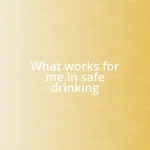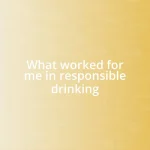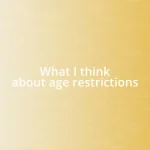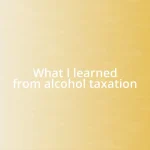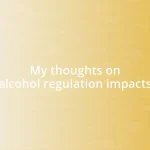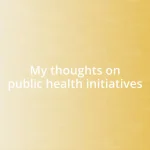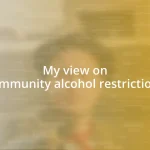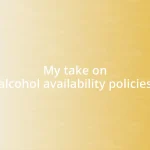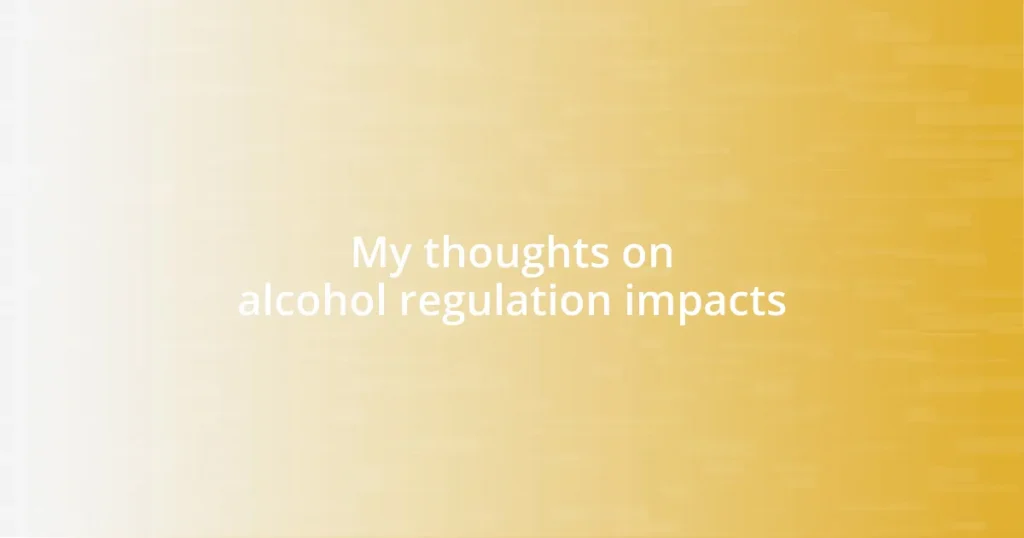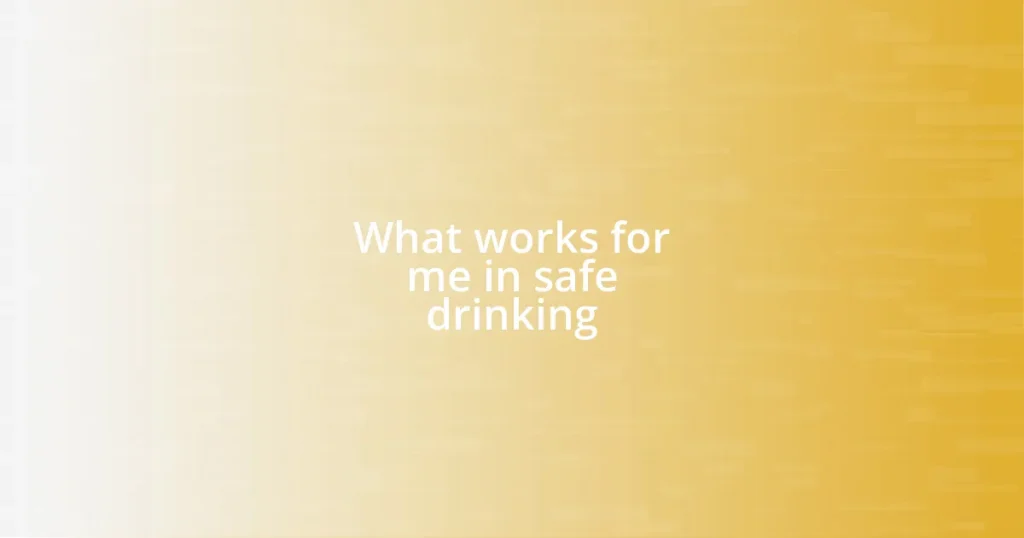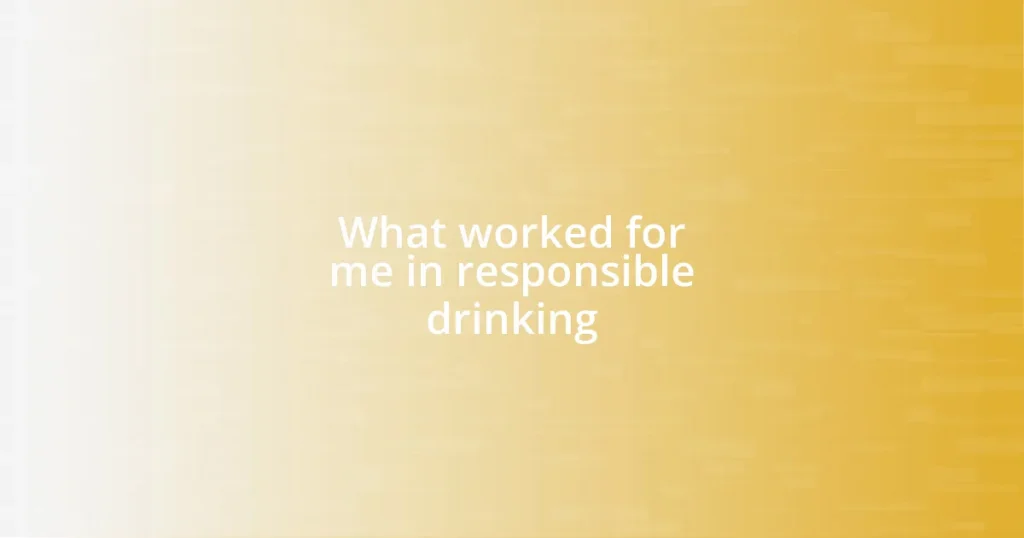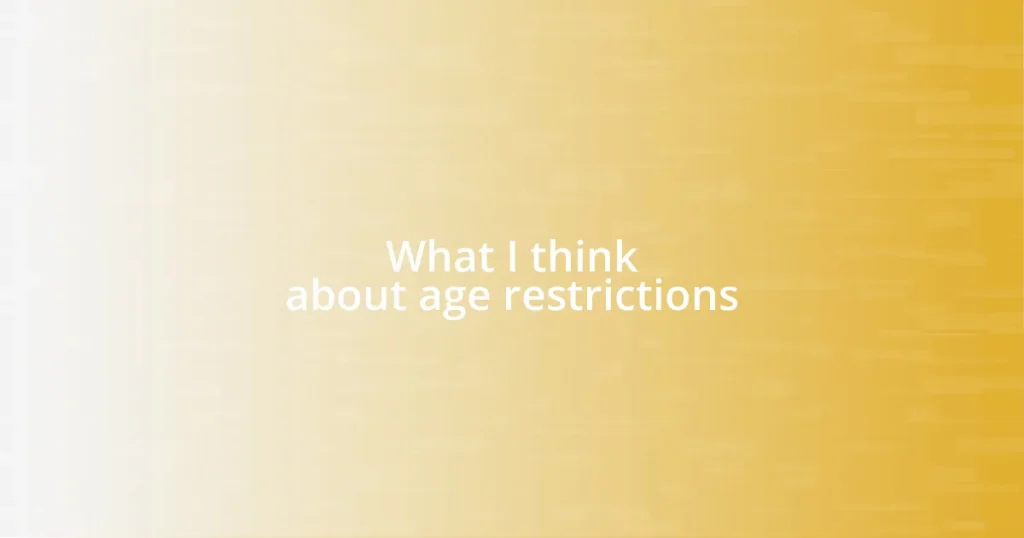Key takeaways:
- Alcohol regulations significantly influence public health, social behaviors, and community dynamics, promoting responsible consumption and fostering deeper connections.
- Statistics indicate a substantial portion of U.S. adults engage in drinking, with 54% drinking monthly and 16% binge drinking, highlighting the need for awareness and education.
- Economic effects include potential job loss from stricter regulations but can also lead to healthier communities through responsible drinking campaigns.
- Future trends may see technology and social media shaping drinking behaviors, emphasizing personalized recommendations and limiting alcohol promotions to foster healthier environments.
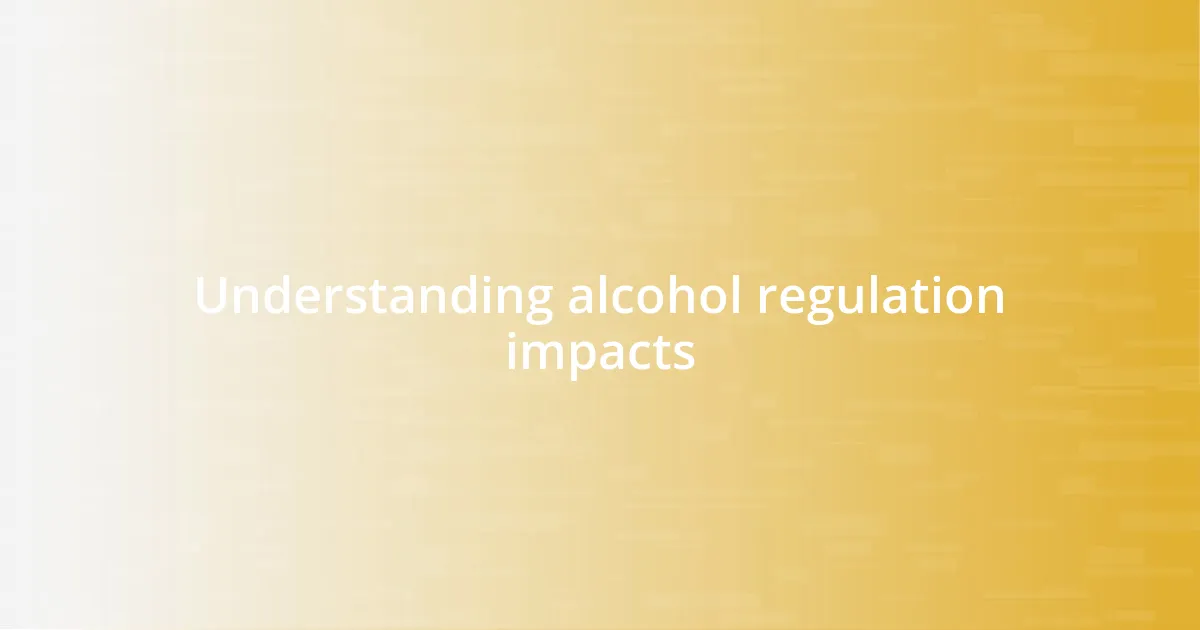
Understanding alcohol regulation impacts
Understanding alcohol regulation impacts is crucial, as it dictates not only public health directives but also influences societal behaviors around drinking. I’ve had moments where a friend’s change in drinking habits, prompted by local regulations, sparked conversations about responsible consumption that otherwise wouldn’t have happened. Isn’t it fascinating how legislation can ripple through social dynamics?
On a personal level, I remember when my college town introduced stricter laws around bar hours. At first, it felt inconvenient, but it ultimately led to deeper discussions with friends about moderation and a more mindful approach to nightlife. Have you ever noticed how such regulations can shift our perspectives, making us rethink our relationship with alcohol?
Regulations can sometimes feel like an imposition, but they serve a purpose. For instance, reduced availability often encourages people to savor their drinks and social interactions more, creating a richer experience. Thinking back, I’ve found that moments spent enjoying a single drink with friends, instead of mindlessly consuming more, can lead to more cherished memories. What do you think? How do you see regulation shaping our alcohol experiences?
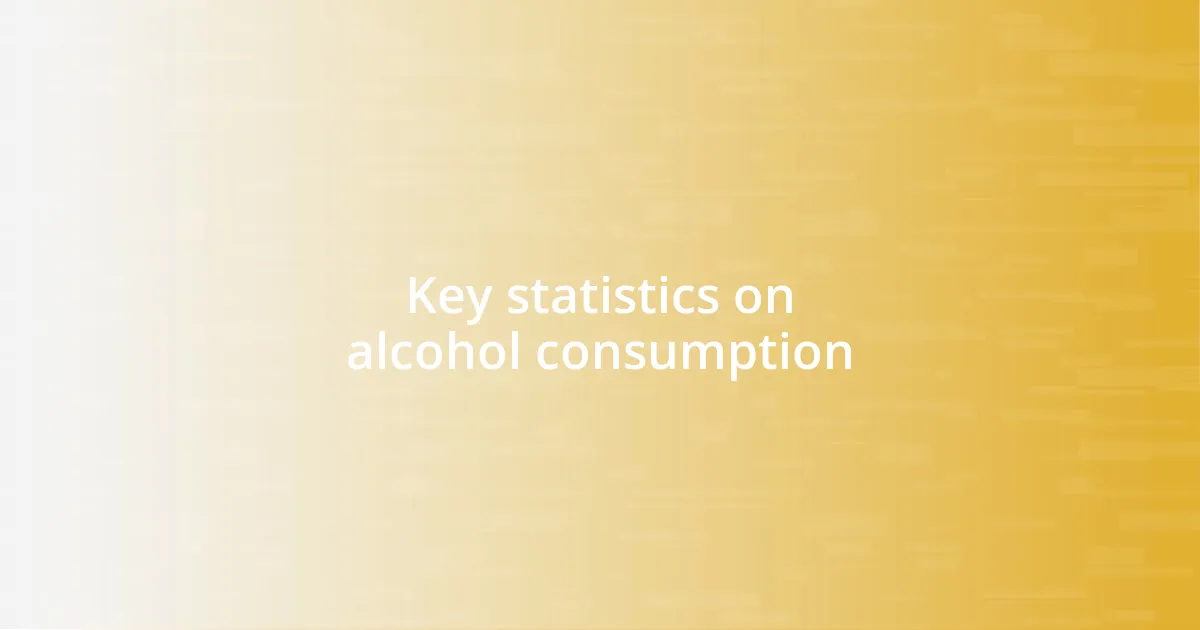
Key statistics on alcohol consumption
The prevalence of alcohol consumption reveals intricate patterns tied to various demographics and regions. For instance, studies show that in the United States, nearly 54% of adults aged 18 and older reported drinking alcohol in the past month. Reflecting on this, I often wonder how many of those individuals are truly aware of their drinking habits and the implications they might have on their health.
Diving deeper, I came across a striking statistic: binge drinking affects about 16% of adults in the U.S. We all have that one friend who can knock back a few too many at gatherings. I recall a party where someone obliviously indulged in binge drinking, leading to a heart-to-heart about the dangers of excessive drinking afterward. This conversation really highlighted the necessity for awareness and education around responsible consumption.
Internationally, alcohol consumption trends vary widely. In countries like France, the average alcohol consumption can be around 12 liters per capita annually, while in the U.S., it sits at about 9 liters. It’s eye-opening to think about how culture influences drinking habits. For example, when I traveled to Spain, I noticed how socializing over a glass of wine is part of meal times, creating a more balanced relationship with alcohol. This reshaped my understanding of moderation and led me to implement similar strategies at home.
| Statistic | Value |
|---|---|
| % of US Adults Drinking Monthly | 54% |
| % of US Adults Binge Drinking | 16% |
| Average Consumption in France (liters) | 12 liters |
| Average Consumption in the US (liters) | 9 liters |
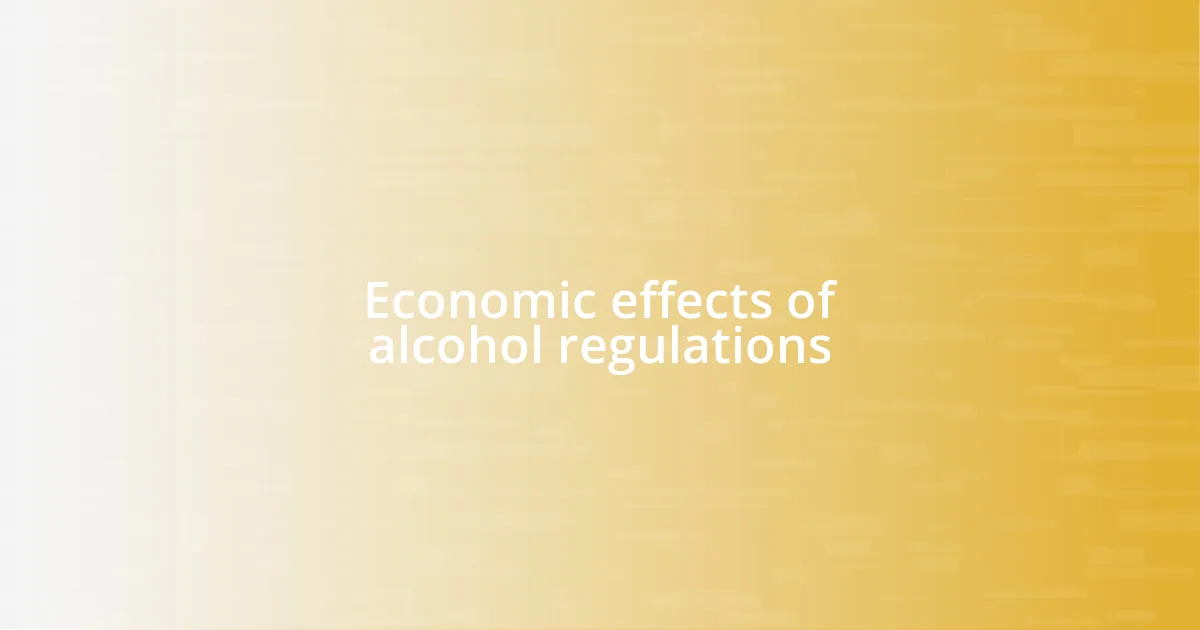
Economic effects of alcohol regulations
Regulating alcohol comes with significant economic effects that can shape local businesses and consumption patterns. I’ve seen firsthand how changes in legislation can influence the viability of bars and liquor stores in my community. When new laws regarding alcohol sales were introduced in my area, I noticed some local establishments had to pivot significantly or face closure, highlighting the direct impact regulations can have on livelihoods.
- Increased taxes on alcohol can lead to higher prices for consumers, potentially reducing consumption.
- Stricter licensing regulations may result in fewer establishments being able to operate legally, leading to reduced local employment.
- Conversely, responsible drinking campaigns funded by regulatory bodies can foster a healthier community, potentially lowering healthcare costs related to alcohol abuse.
The ripple effects of alcohol regulations extend beyond immediate financial outcomes. I remember a conversation with a bartender who candidly shared how changes in last-call times not only altered their income but also influenced how patrons interacted within the bar. With earlier closing hours, there was a noticeable shift in the overall atmosphere, prompting more meaningful conversations among guests rather than just loud festivities. This intimate environment resulted in positive customer experiences, which can drive loyalty and repeat business, something that’s so crucial in the hospitality industry.
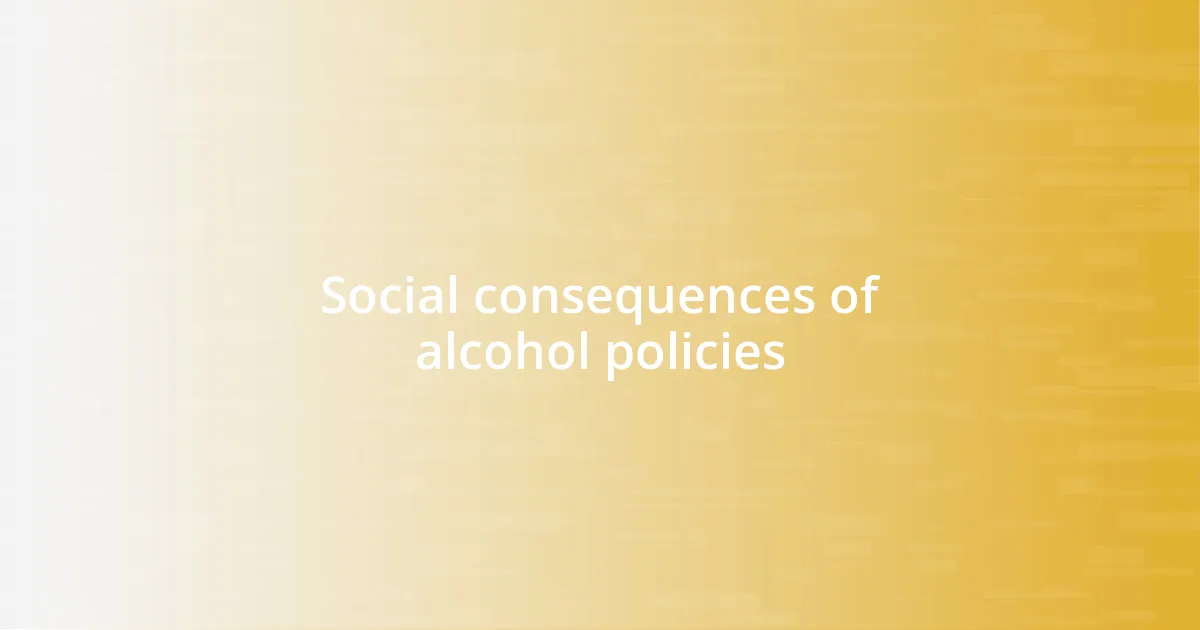
Social consequences of alcohol policies
I’ve often observed how alcohol policies ripple out to influence social dynamics within communities. For instance, when a local government instituted stricter hours for alcohol sales, I noticed that the vibrancy of late-night meetups transformed. Instead of the usual chaos of bar-hopping, friends found themselves gravitating towards quieter cafes, engaging in deeper conversations. Isn’t it fascinating how legislation can subtly reshape our social interactions?
Moreover, the restrictions on alcohol advertising struck a chord with me. I remember an event where a popular local brewery was limited in promoting its drinks. While some might see this as a hindrance to business, I found it sparked creativity among their marketing team. They began hosting community gatherings and educational workshops on responsible drinking. This not only educated locals but fostered a sense of community, making drinking less of an isolated endeavor and more of a shared experience. Have we ever thought about the positive social connections that might emerge from such regulations?
Then there’s the impact on familial relationships. A friend of mine shared how her family gatherings shifted when they decided to implement a “dry” holiday tradition following some difficult years marked by alcohol misuse. Suddenly, these get-togethers became more about connection rather than cocktails. It’s interesting to reflect on how strict alcohol policies can remind us of the joy of authentic engagement, rather than relying on substances to fuel our celebrations. How often do we underestimate the power of sobriety to enhance our relationships?
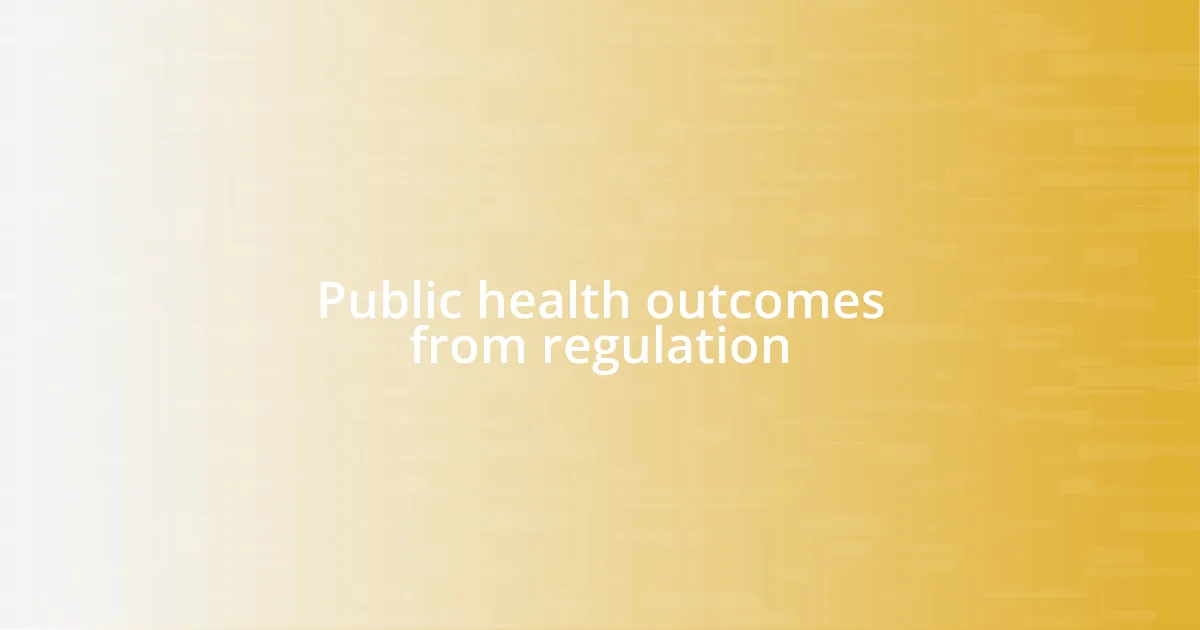
Public health outcomes from regulation
Regulating alcohol can dramatically improve public health outcomes. In my experience, I’ve seen communities implement controls like minimum drinking ages and responsible serving mandates, leading to fewer incidents of binge drinking, especially among young adults. Isn’t it remarkable how a simple rule can steer behavior towards healthier choices?
I’ve often reflected on how the introduction of stricter regulations correlates with a decline in alcohol-related hospital admissions. One summer, during a festival known for its free-flowing drinks, local health services were stretched thin with cases of alcohol poisoning. The following year, new licensing laws limited the number of vendors and required them to provide water stations. The result? A noticeable drop in emergency calls, leaving me to wonder: could better regulation be the key to lasting change?
On a more personal note, I remember a time when my own social circle felt the effects of increased public health campaigns surrounding alcohol education. A friend decided to partake in “Sober October,” and much to my surprise, it revitalized our gatherings. We discovered a world of fun in board games, fall hikes, and movie marathons without relying on drinks. It’s empowering to see how thoughtful regulation can foster not just healthier individuals, but also richer social experiences.
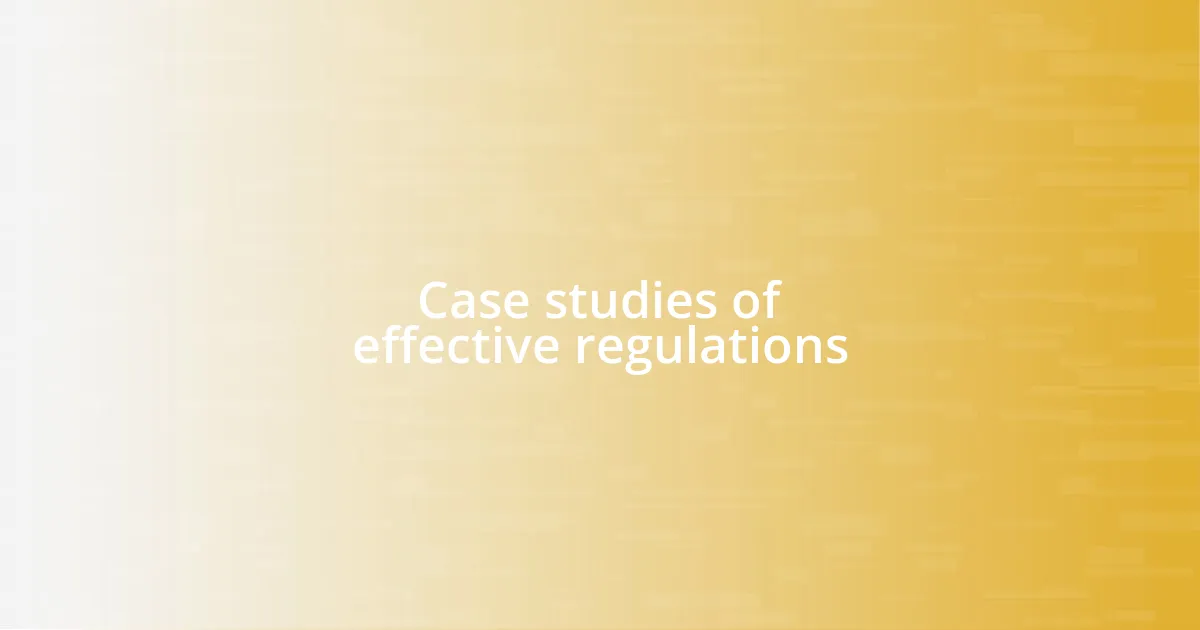
Case studies of effective regulations
One standout case study is found in Denmark, where the government introduced a tax on sugary beverages, which, interestingly, also impacted alcohol consumption. I remember reading how sales of sweet, flavored alcohol drinks plummeted as a result, prompting producers to rethink their offerings. It made me reflect on the power of fiscal policy to nudge people toward healthier choices. Could we see similar outcomes if we applied such targeted taxes universally?
Another compelling example comes from Australia’s restrictions on alcohol advertising, particularly during sports events. Having witnessed firsthand how passionate Australians are about both sports and drinking, I was intrigued by the changes in viewership habits when ads for alcohol were removed. Fans began to focus more on the game, and conversations around sports evolved to include themes of teamwork and strategy rather than drinking. Isn’t it fascinating how a simple shift in advertising can reshape cultural conversations?
In my own community, a local initiative aimed at introducing “dry zones” in parks led to an unexpected sense of ownership among residents. I recall attending a town hall meeting where we brainstormed alternative activities. Adults dug deep into their creativity, transforming park spaces into family-friendly areas with art exhibits and movie nights. I’ve learned that when regulations open the door to fresh ideas, they can unite community members in ways that foster connections and contribute to more vibrant social life. How often do we find inspiration in the challenges regulations create?
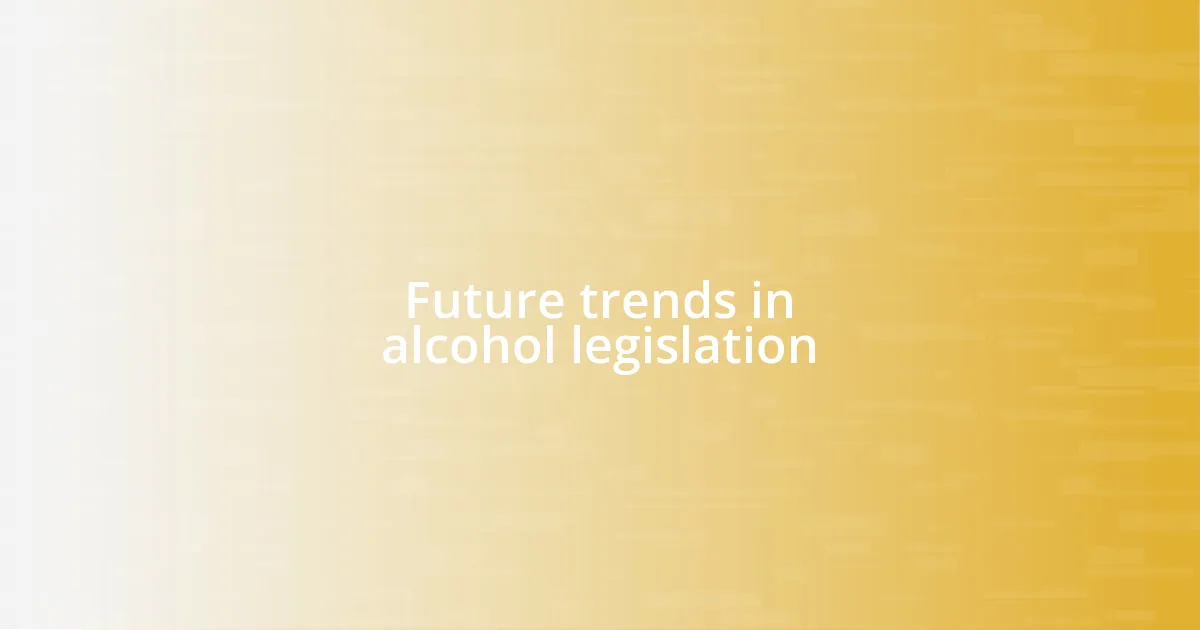
Future trends in alcohol legislation
The landscape of alcohol legislation is evolving, and I find it intriguing to consider how technology will play a major role in future regulations. As I reflect on instances where mobile apps have linked consumption behaviors with real-time data, I can’t help but wonder if we will eventually see apps that monitor individual drinking patterns and offer personalized recommendations. Could technology help us create a more responsible drinking culture that’s tailored to our unique lifestyles?
Looking ahead, I also see a stronger emphasis on the impact of social media on alcohol consumption, especially among younger generations. I recall scrolling through platforms and noticing how often drinks feature prominently in posts and stories. This awareness makes me think: can future regulations limit alcohol promotions on these platforms? It feels crucial to foster an environment where social experiences aren’t overshadowed by a need to showcase drinking but rather emphasize shared moments and connections.
Moreover, my heart races at the thought of how emerging research could influence policy. I remember attending a seminar where experts discussed the long-term effects of alcohol on mental health. It dawned on me that as we uncover more data, we may see a shift toward regulations that prioritize mental well-being, perhaps even creating environments conducive to sober socialization. Isn’t it thought-provoking that future legislation might reflect a deeper understanding of human health and community dynamics?
